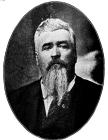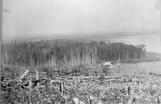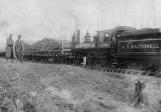1
Mr. J.J. Grills, Crown lands agent1910
New Liskeard, Ontario, Canada
 Credits:
Credits:Agricultural Temiskaming, 1910
2
Agricultural Development in Early TemiskamingIn the late 1800's logging companies began reporting some stone- free, fertile land at the north end of Lake Temiskaming. The only access to the area was by boat up the Ottawa River and the long Lake Temiskaming.
The government of the day saw the need to have the land surveyed and the district boundaries marked. This was needed so longing companies could keep within their permit areas.
When it became apparent that the area would attract settlers, the government appointed a land agent. The townships were laid out in thirty-six square mile blocks with six hundred and forty acres. Four farms, in a square mile.
3
Newly cleared landEarly 1900's
New Liskeard, Ontario, Canada
 Credits:
Credits:Agricultural Temiskaming, 1910
4
The land was all covered in forest and it had to be cleared. The only power available came from horses, oxen and human muscle. The tools were axes and crosscut saws. The settlers found ingenious ways to remove the stumps using chains and pulleys. A large timber frame, six to eight feet high, would be pulled over the stump. A set of tongs, driven under the roots of the stump, attached to four to six sets of pulleys and team of horses could lift a tremendous weight.Big stumps would be left over winter so the frost could loosen the clay soil from the root system. Stumps would then be piled up and burned. It was always slow hard work!
Settlers started from the lake and river systems to stake out their homesteads.
5
Laying the rail line for Temiskaming and Northern Ontario Railway1902-1905
North Eastern Ontario
 Credits:
Credits:George Dukovac
6
The Temiskaming and Northern Ontario Railroad was being built and reached the southern edge of Temiskaming in 1905. Silver was discovered in the area that became the town of Cobalt. With that discovery came a rush of miners. This sudden influx of people provided a ready market for the produce of the new farms.Word about the agricultural possibilities spread through southern Ontario, Quebec, the British Isles and Scandinavia. With mining, logging and agriculture, Temiskaming drew a rich collage of nationalities to the area. Much of the land was claimed during the period from 1900 to 1920.
7
Team Kate and Kit, driven by Roy Peters, mowingCirca 1942
New Liskeard, Ontario, Canada
 Credits:
Credits:Little Claybelt Homesteader's Museum
8
Horses were a valuable asset. They did the heavy farm work. They were the main means of transportation into town for groceries and feed supplies for whatever livestock the farmer had. Horses were still widely used right into the early 1940'sA variety of steel wheeled tractors arrived on the scene. As the use of tractors increased, the value and use of horses declined. By the 1940's nearly every farm family had a car or truck of some kind.
9
Cutting oats on Mr. George Slade's farm1910
New Liskeard, Ontario, Canada
 Credits:
Credits:Agricultural Temiskaming, 1910
10
This was a new land with weather conditions much different than most of the settlers had ever known. They were eager to learn of new crops and methods of production.The Ontario Department of Agriculture saw the potential and established an office at New Liskeard. A Mr. Nixon was the first representative and there aren't a lot of records of his team. Milford F.Cook was the next agricultural representative. He was an enthusiastic proponent to helping the farm people get the training and education they needed to make a living for their families.
